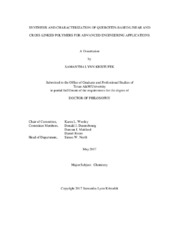| dc.description.abstract | We have a keen interest in the design, preparation and investigation of engineering polymers that are derived from renewable biofeedstock resources. Natural products allow for access to diverse structures and provide a variety functionalization groups, which lead to many routes for the design of monomers and their subsequent polymerizations. Quercetin and its derivatives are well-studied molecules with interesting bioactivities, making them ideal to be incorporated into the backbone of different types of polymers. Four systems of either linear polycarbonates or epoxy cross-linked networks have been synthesized and characterized extensively. First, the monomer 3,7,4’-tribenzylquercetin was synthesized followed by condensation polymerizations to afford linear polycarbonates of various molecular weights. The photophysical properties were examined and compared to the monomer, including the identification of uniquely-high levels fluorescence emission intensity and quantum yield. Upon further exploration of the mechanism for this unexpected fluorescence, aggregation-induced emission (AIE) was found to contribute to this photophysical phenomenon. The identified AIE properties were further utilized in a second system for the incorporation of quercetin segments into micelles. The copolymerization of two quercetin-based monomers followed by “clicking” on various grafting percentages of poly(ethylene glycol) afforded amphiphilic macromolecules. The quercetin-based macromolecules were assembled into micelles and found to be fluorescent and non-cytotoxic to various cell lines, therefore demonstrating potential for applications in drug delivery. In another system, after several unsuccessful attempts of synthesizing a polycarbonate with a protected catechol moiety of quercetin, copolymerization of this monomer with a lysine-containing tripeptide was achieved. Deprotection of the polymer to afford catechol and amine moieties will open opportunities for these materials to be potentially applied as biomedical adhesives. In the final explored system, a 3,7,4’-trimethylquercetin diglycidyl ether-nadic methyl anhydride cross-linked network was synthesized and was shown to exhibit comparable thermal and mechanical properties to the diglycidyl ether of bisphenol A-nadic methyl anhydride networks. Overall these quercetin-based materials represent a new class of environmentally-friendly networks with potential for various engineering applications. | en |


